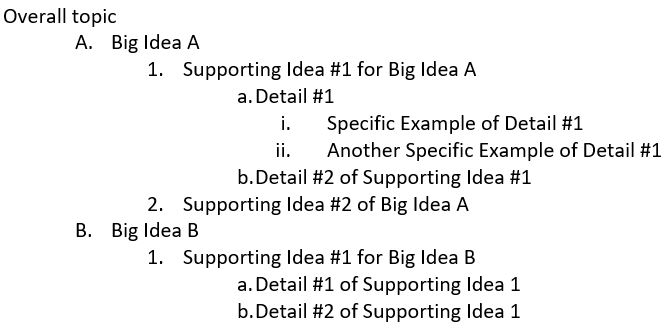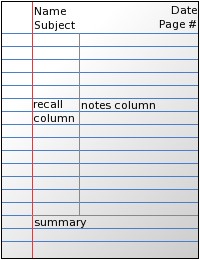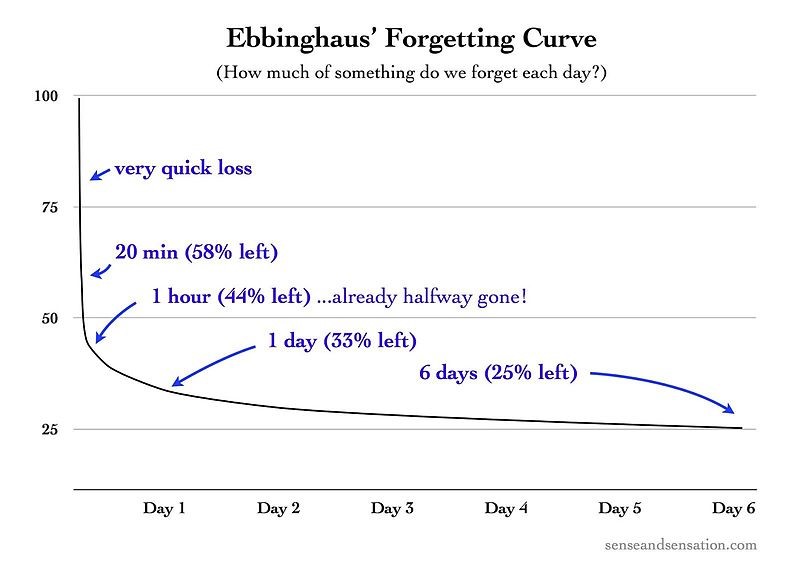Note-Taking Methods: 3 Great Ways to Take Better Notes!
As I was thinking about writing this blog post on note-taking methods, I had a flashback to my freshman year of college. I was in the middle of a mid-term exam in an Introduction to Psychology class. The exam seemed to be going well up to that point, or so I thought, that is…until I got to ‘the question’. I read ‘the question’ and sat there frozen for the next several minutes as ‘the question’ was worth 40% of the exam grade. I remembered the professor talking about the concept in class, but the answer totally slipped my mind. If only I had used one of the note-taking methods we are going to discuss today!

It was then and there that I learned the importance of good note-taking methods. We will come back to ‘the question’ a little later, but in an ironic twist, ‘the question’ was not only the catalyst for my learning note-taking methods, but it is also one of the reasons for…
Why Taking Notes is Important
Whether it is in a business, life, or academic setting, taking notes is important for a variety of reasons:
It makes you focus better – remember in a recent post we did on how to learn faster, one of the things that all of the research agrees on is that you need to be an active learner – one of the best ways to be active is to utilize one of the note-taking methods in this blog post.
It can help clear up disagreements later – how many times have you been in a meeting and disagreed about something that was said or agreed upon at a previous meeting? Taking good notes helps silence any of these doubts or disagreements.
Serves as review material – whether you are formally studying or learning on your own, reviewing your notes is a great way to retain information
Less stress – forgetting either what someone said or something you learned can be a big cause of stress; having good notes that you can refer back to can help alleviate this stress.
??? – the last reason is one you will need to wait until the end of the blog post to see!
When to Take Notes
There are a variety of situations where you may want to utilize note-taking methods in your life:
Academic: if you are a student.
Team meetings: if you are in a team meeting, you can take notes for your eyes only, or with the intention to share with others later on.
One-on-one meetings: if you are in one-on-one meetings, whether it is a meeting with your boss, someone on your team, your mentor, an interview.
Self-learning: if you are trying to learn something for your own need or want, such as watching a video, reading a book, listening to a podcast, taking a course on Coursera, at a conference, personal development event or workshop – whatever.
Now that we know why and when to take notes, let’s take a look at 3 popular…
Note-taking Methods
We are going to introduce you to 3 of the most common note-taking methods that can be used in either the business world, academic world or simply when you are trying to learn stuff on your own. I have used all 3 in different situations.
The first method we will introduce is one many of you may be familiar with which is called the…
Outline Method:
This is a traditional method where you use headings, letters, numbers, and indentation to structure your notes, such as:

How you utilize this method depends on how many ideas, details, and examples you have.
Cornell Method:
Developed by Dr. Walter Paulk at Cornell University in Upstate New York, this method takes your typical 8 ½ x 11” sheet of paper and divides it into 3 sections, like this:

The three sections are as follows:
Notes Column: this is the section where you take your detailed notes.
Recall/Cue Column: this column stays empty until the end of the class or meeting where you put bullet points, questions or summary statements.
Summary: this is the section where you summarize everything in the cue and note taking areas into a few concise sentences.
The process for taking notes using the Cornell method utilizes a 5-step process suggested by Linda Wong1, called the 5 R’s:
Record: by writing down notes in the note taking area using whatever important information there is using a format you are comfortable with (perhaps the outlining method or in paragraph format). Be sure to identify the main points and capture the main ideas discussed.
Reduce: condense your notes right after the class or meeting into keywords that you write into the Cue column. These can be key/cue words or phrases that summarize the discussion or questions that you need to clarify here.
Recite: now it is time to review and recite from your memory what you have learned. You may want to use the key/cue words or phrases in the Cue column to prompt you as you talk through concepts, key points etc.
Reflect: after looking over and reciting your notes, take some time to simply reflect on the notes and write a summary in the section at the bottom.
Review: take some time to briefly review your notes to cement things even further in your head!
The Split-Page Method:
The last of the 3 note-taking methods we will cover is called the split-page method and it is a pretty simple one. You simply divide your page in half with a vertical line down the middle of the page. The left side of the page is for your main ideas and the right side is for your secondary ideas. I have also seen this called the ‘capture and create method’.
The idea is to use…
The LEFT side to take notes and write down whatever either the speaker/teacher/other person is saying.
and to use
The RIGHT side to write down your feelings, your thoughts, your impressions – this is where you are more creative/analytical
All three note-taking methods can be used in all of the areas we discussed above (academic, team meetings, one-on-one meetings, and self-learning). Personally, I like to use the Cornell method in meetings/academic situations and the outlining method for self-learning. But that’s just me, you need to find what works for you!
Before we go, let’s look at some…
Tips to Help You Take Better Notes
Use a pencil and paper: – as we said in a previous post, taking notes by hand is recommended over a computer as numerous studies have shown you are more likely to remember it if you write it by hand.
Utilize these shortcuts: to write less and save time:
Acronyms: for example, ASAP, TBD, FYI, AKA
Symbols: for example, use = for equals, use + for in addition to
Abbreviations: for example, FL instead of Florida
First syllable: for example, gov for government, subj for subject, Jan for January
Leave out vowels: for example, mktg. for marketing, mtg. for meeting
Apostrophes: for example, int’l for international, gov’t for government
Unimportant words: leave them out, for example, a/on/is/am etc/the
Get graphic! Ok, get your mind out of the gutter – I dont mean that kind of graphic! Another type of notetaking that we covered in a previous post is mind-mapping which is a great tool for brainstorming.
Ditch the highlighter! Another study showed that highlighting and underlining was no more beneficial than simply reading!
Filter and Prioritize! – figure out what is important and what is not.
Review your notes: according to this study, taking notes and reviewing them after, led to maximum recall and retention efficiency vs. listening only. The main benefit in taking notes for recall was no the taking of the notes itself but the review of them afterward.
Use white space – to separate main thoughts or ideas.
Use your own words – using your own words will help you remember stuff much better.
Know your ‘why’ – get clear on why you are taking notes in the first place.
Get organized – the more organized you are, the better you will remember.
One more thing…
Back to ‘The Question’
Luckily for me, I was not the only one who failed to answer ‘the question’ correctly. Being that the concept was an important one, the professor gave us all a reprieve and told us that it would be on the final as well. The ironic part is that the answer is also one of the reasons that using note-taking methods is important!
‘The question?’
“Define and explain the concept of the forgetting curve and draw the graph.”
The answer:
While we have all heard of the learning curve, there is a thing called the ‘forgetting curve’. The forgetting curve was created by Hermann Ebbinghaus over 100 years ago and it basically says that if we have done nothing with the information we have learned we will have forgotten roughly half of it within an hour, 70% of it within a day and 90% within a week.

The moral of the story: Taking notes can help you ward off the forgetting curve and remember stuff you have learned for days, weeks, and even months!
Until next time, ward off that forgetting curve by taking good notes and as always…PYMFP!
–Rick
Use It or Lose It:
When taking notes, utilize one of the 3 note-taking methods above (the Outline Method, the Cornell Method or the Split Page Method). Also, make sure to utilize the tips on how to take better notes.
When to Use It These Note-Taking Methods
When you are trying to learn something, either in an academic environment or for self-learning, or in a one-on-one or group meeting.
What Do You Think?
Are you someone who takes notes? Do you use any of the note-taking methods we discussed? Do you have any other note-taking methods or tips that we didn’t cover? Please share in the comments below!
If you enjoyed this post, it would mean the world to us if you shared it with people you care about via any of the social media platforms below!
Popular Previous Posts:
12 Amazing Things I Learned from W. Edwards Deming
This is How to Boost Your Creativity Using Lateral Thinking!
12 Great Pieces of Life Advice from Old Steve Jobs Videos
How to Learn from Experiences With an After Action Review
Being Optimistic By Keeping Your Line in the Water!
References
https://www.csustan.edu/sites/default/files/groups/Writing%20Program/forgetting_curve.pdf
https://www.nrcs.net/Downloads/Cornell-Note.pdf
1 Wong, Linda. (2009). Essential study skills. Boston, MA: Houghton Mifflin Company.
http://www.dunwoody.edu/pdfs/Elftmann-Note-Taking-Structures.pdf
https://ivypanda.com/blog/everything-you-need-to-know-about-note-taking/

I must be brutally honest – I have never heard of any of these three techniques. I read through the three methods and decided “too much trouble” and “too structured” and besides I had developed my own way of documenting a meeting or group telecon which worked for me. Basically I used what you described under “utilize these shortcuts”.
You can add to your shortcut list –1) identify the speaker(s) or participants by initials. 2) draw arrows or connecting lines to link similar subjects. 3) neatness does not apply.
With that info jotted down, I could basically reconstruct the meeting from start to finish., who said what, who agreed, who disagreed, who suggested alternatives, was a decision made or was it deferred, are there action items, who’s responsible, when is the due date.
Immediately after the meeting concludes and when your mind is fresh (left side of the Forget Curve), start writing and translate your notes into sentences. In the old days, the secretary typed up the final report. In the modern era, I used Word and converted my scribbling into English on the computer screen.
I employed this system successfully for over 30 years.
Hi Dave, Ya these methods aren’t for everyone – but it sounds like you use some of the shortcuts. Sounds like you had a great little system yourself, thanks for sharing your wisdom as always! I especially like how you write and translate your notes into sentences right after the meeting – that definitely is key to remembering stuff. Thanks again and talk soon, Rick